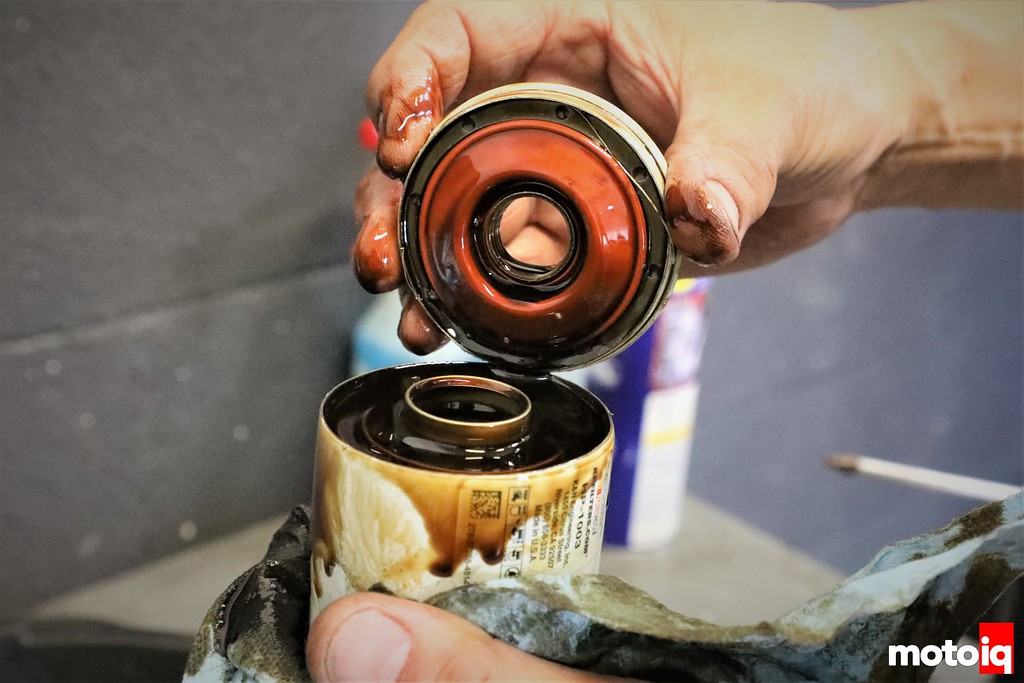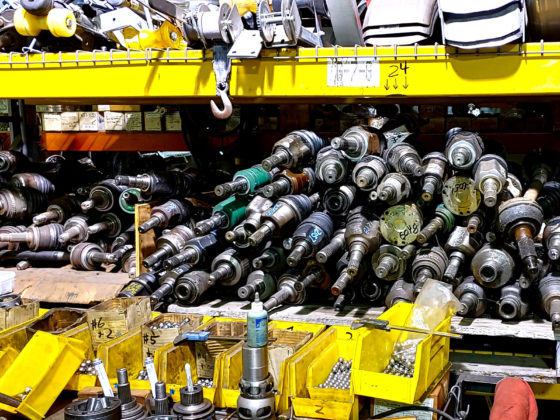
One of the most important things to do when maintaining an engine used in competition or any sort of hard-driving is to constantly monitor its condition and do preemptive service or maintenance when required. Besides the compression and leak down tests that ascertain the condition of the engines valve and ring seal we often take a look inside the oil filter to search for any remnants of bearing material or other debris. This is done by cutting the used oil filter open using a special tool and inspecting its insides. Several companies make oil filter cutters but one shown here that we use is made by Longacre Racing Products.
Longacre makes a lot of race-specific chassis and other tools that can make your life a lot easier. We got our oil filter cutter from Pegasus Auto Racing. Pegasus is our go-to place for race car specialty parts and tools. They have fast service and everything is usually in stock.
For competition cars, we usually inspect the oil filters insides at every service interval and it is not a bad idea to do this even in your streetcar. We inspect the inside of the filter for sure if the car had been run hard, overheated, low on oil or if there has been some sort of issue with oil pressure. The filter is a depository for debris created inside your engine which makes having a good look at the insides of them when you change your oil or experience some hard use is always a good idea.

We use a filter cutting tool made by Longacre Racing Products. It makes filter cutting easy enough so you have no excuse not to do it. The tool has two ball bearings that act like rollers and a cutting wheel that works like a can opener or pipe cutter that is attached to a handle/ cutting wheel depth adjuster.

You simply rest the cutter on top of the old filter like this, adjusting the cutting wheel depth and spinning it around adjusting the cutting wheel deeper and deeper as you spin the cutter around. It works just like using a plumbers pipe cutter. The Longacre tool quickly cuts through the filter body in seconds. The cutter is perfect for this job as it does not make any metal shavings while cutting that might confuse you like a saw or cut off wheel would.

The top of the filter comes right off! Yes, we recommend doing this over a drain pan because the filter will be full of oil. It’s a good idea to pour the oil into a clean drain pain where you can first inspect the oil for metallic shavings. A sheen of tiny metallic particles that give the oil in the filter a look of mother of pearl is normal. These particles are so small that you can’t really see them, they just give the oil a pearly look. They are mostly small bits of iron and aluminum that come from the pistons, rings and cylinder walls that get worn off in normal use. A brand new engine will have a lot of this mother of pearl looking oil as it comes from the rings seating and the valvetrain burnishing in.
What you are looking for as bad bits are bigger flakes of metal, shavings or things that look like filings. These are debris that are probably coming off your engines reciprocating assembly, like bearings, thrust bearing, crank journals and even the rods in a case of a spun bearing. These sorts of debris are not a good sign.

With the cap cut off the top of the filter, its guts come right out. Here are the internal parts of the filter that need inspecting for metal particles. The filter element, the case, and the stamped sheet metal leaf spring for the anti-drain back valve are all parts that can get covered with easy to see metal fragments.




7 comments
You can also remove the filter element from the stamped steel end pieces and lay it out on a clean piece of paper or a drain pan. You can use a box-cutter to remove the paper element.
That is a good idea as well.
This is a great idea. I like that newer German vehicles make this easier with a replaceable filter, instead of a canister (saves on waste, too.)
I also do a couple things that I learned from watching Best Motoring, on all my filters:
One is to put neodymium magnets on various locations of the filter, although I should probably cut one apart to see if I am collecting bits of iron.
Second, is to use two hose clamps (especially on big filters), around the filter (not too tight), as the thin steel walls of the canister will actually flex under high oil pressure, and the volume change can actually effect your oil pressure. This would be more important with Honda VTEC motors, as VTEC engagement depends on oil pressure being high enough to actuate the VTEC solenoid.
The hose clamp is actually to prevent blowing off the filter case if you have disabled the bypass which some racers do. The magnets will collect ferrous debris but not non-ferrous like aluminum and bearing material.
Hi Mike,
Yeah, the magnets and hose clamps are cheap, easy mods, so I do them on my cars (my current vehicle has a huge oil filter, so the walls might actually flex a little bit.) Also, I know that not all oil filters have bypass valves, too. (Although, I always buy them with a bypass.)
I got the ‘hose clamp tip’ from an episode of Best Motoring VTEC Club with Spoon’s Ichishima-san. The hose clamps also help when it comes to removal if you have a stubborn filter.
Interestingly, they also sell a ‘ASM Oil Filter Stopper’, that utilizes a hose clamp wired to a small bracket. I am pretty sure that just about anybody could fabricate an oil filter stopper for themselves. (I had no idea that a filter could spin off on an S2000. Wow! That’s gotta suck.)
http://www.gotuning.com/product_info.php?fPath=S2000_2_42&products_id=923
Actually, I didn’t know much about how/when the Bypass Valve operates, so this forced me to do some schooling:
The Bypass Valve
Under ideal conditions, the bypass valve will never open. When it opens, the oil by passes the filter and goes on through to the motor, obviously unfiltered. It is a safety valve. However, in real operation, it opens often.
One example is when you start the motor when cold. The oil is thick and does not pass easily through the filtration medium, thus building up to a high pressure drop. So, the bypass valve opens to prevent oil-starvation of the motor. How long it stays open is dependent on how cold the oil is and how long it takes to get near operating temperature. When the pressure drop across the filtration medium drops below the bypass valve setting.
Another example can occur when the motor is fully warmed. At idle, the oil pressure is about 15 to 20 psi, and the pressure drop across the filter is about 1 or 2 psi. You take off towards the redline, and quickly build oil pressure. During that full-throttle acceleration the pressure drop across the filter will exceed the bypass setting, and send unfiltered oil to the motor, until the pressure across the filter has time to equalize. During a drag race, shifting through the gears, the bypass will open several times.
A third example, which you should never experience with frequent oil and filter changes, is when a filter becomes clogged. A spin-on filter can commonly hold 10 to 20 grams of trash before it becomes fully clogged. The bypass valve opening is the only way to keep the motor from becoming oil-starved if the filter becomes clogged.
According to Purolator, the Honda OEM filter bypass setting is 12 to 14 psi. WIX (NAPA Gold) builds their oil filters with a bypass setting of 8 to 11 psi, while AC Delco builds theirs to a setting of 11 to 17 psi. How much do these differences matter? I don’t think anyone knows, even the engineers, and each has its own set of advantages and disadvantages.
If you do lots of racing, you’re probably better off with a higher bypass setting.
If you do lots of *cold* starting, especially in the winter, or seldom change your filter, I think you’re better off with a lower bypass setting. However, with few exceptions, bypass pressures for spin-on filters run in the 8 to 17 psi range, and any of them should work acceptably.
As you can see, some bypass valves are built directly in the middle of the filter while a few do not have one.
https://www.bobistheoilguy.com/forums/ubbthreads.php?ubb=showflat&Number=309756
Thank you for this useful information. Keep it up
In case of new bearings or other components break-in period should we expect more debris to accumulate there? And if so, by how much more?
Thanks